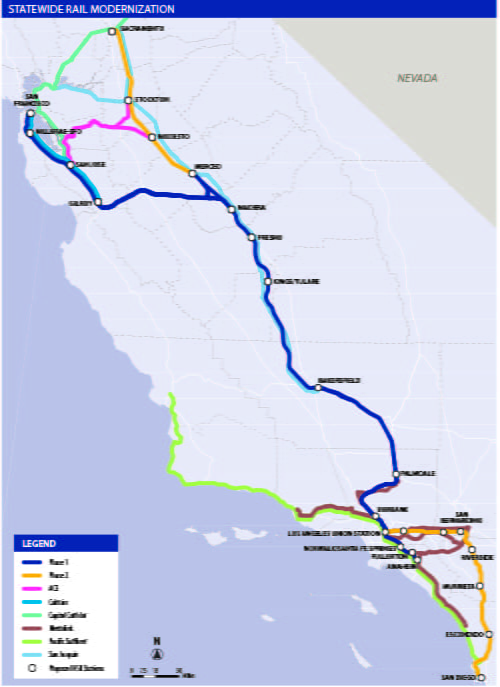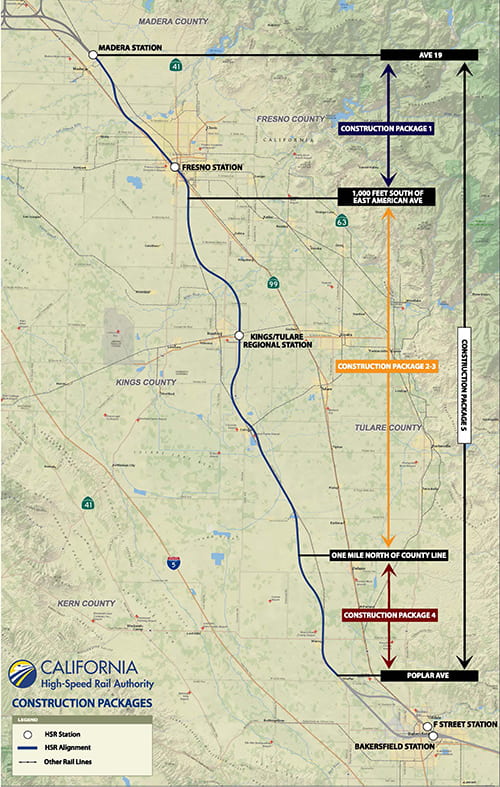Controversial California High Speed Rail Project Offers Infrastructure Lessons
MuniNet’s multi-part series take a closer look at some of the more significant and interesting high speed rail projects and plans going on throughout the United States. The aim is to take a critical look at the potential benefits sought by each project, the stages of development, and the challenges and drawbacks involved.
Part II of this series on high speed rail projects looks at the California High Speed Rail Authority. California High Speed Rail aims to connect San Francisco and Los Angeles, via a high-speed train reaching speeds of 200 m.p.h. A brief history of the activities of the Authority are:
- 1996 – Authority founded to plan and design a high-speed rail system connecting California’s major metropolitan centers. The growing population of the state was and continues to put a strain on highways, airports, and conventional rail infrastructure.
- 2000 – Authority releases its first Business Plan
- 2002 – State Senate approval of $9.95 billion bond issue to finance the system
- 2008 – After years of delay, bond measure voted on public ballot, and passed.
- 2009 – Additional $3.3 billion in Federal funds secured through American Recovery and Reinvestment Act
- 2012 – Governor Brown signs into law $8 billion in appropriations to begin construction
- 2012-Present – Construction begins in various contract phases
It may seem obvious, but project managers and policy makers must keep the following in mind: Long-term benefits and financial viability depend on a lot of paying passengers using the rail service.
The project is controversial because it has suffered substantial delays and cost overruns, which contribute to political opposition. According to a report obtained confidentially by the Los Angeles Times, the overruns are attributed to management issues. Additionally, delays and underestimates of costs in producing environmental impact reports, and purchasing property where the line will be built, have contributed to the problem.
Despite implementation struggles and questions about future financial viability, the project has already been a job-creator. So far, the Authority has spent $2.2 billion in investments in planning and construction. These investments have resulted in an estimated 19,900-23,600 direct and indirect job-years*, and $3.5-$4.1 billion in economic activity, over the decade from 2006-2016, according to a report issued this month.
The California High Speed Rail project is also forecast to have significant environmental benefits. The project is mandated to be able to operate entirely off of renewable energy sources once complete. A 2014 report summarized the environmental impacts:
- Reduction in Vehicle Miles Traveled
- By 2040, the system will reduce vehicles miles of travel in the state by almost 10 million miles of travel every day.
- Over a 58 year period (from the start of operations in 2022 through 2080), the system will reduce auto travel on the state’s highways and roads by over 400 billion miles of travel.
- Daily Number of Flights Diverted
- Starting in 2030, the state will see a reduction of 93 to 171 flights daily.
- By 2040, the state will see a reduction of 97 to 180 flights daily.
- The high-speed rail system will save 2.0 to 3.2 million barrels of oil annually starting in 2030.
- In 2022, when the Initial Operating Section (Merced to the San Fernando Valley) is up and running, the resulting GHG reductions will be between 141,000 to 330,000 metric tons of carbon dioxide (MtCO2 ) in the first year, the equivalent of taking 31,000 passenger vehicles off the road.
The big question is of course, is all this worth it? A proper measure is determining the value through cost-benefit analysis, and what the net present value** is of the project. A cost-benefit analysis of the California High Speed Rail project was performed in 2014, which estimated a positive net present value for the initial project. The NPV was found to be even higher when including future expansions. The analysis found that the total economic value of all benefits are $25 billion higher than all the costs in today’s dollars.
An article from Forbes points out a potential flaw in the cost-benefit analysis; that it overvalues the time saved by travelers moving from driving and traditional rail to high-speed rail. He basis this off two ideas. First is the idea that, if both types of rail have wireless internet access, the value of the time saved is lower, because riders can work or enjoy leisure, increasing the value of the commute itself. Second, he makes the argument that self-driving cars will be in widespread use sooner rather than later, which will also boost productivity of people travelling by automobile, also allowing them to work or enjoy leisure in ways one cannot while concentrating on operating a vehicle.
His observation is insightful, particularly around the true economic benefits of time saved via high-speed rail over traditional rail. However, the assumed economic benefits of time saved in this report are in line with U.S. Department of Transportation standards that are widely used in these types of infrastructure projects. If it overstates the benefit of time saved, so do cost-benefit analysis of infrastructure projects generally; while this is a problem if true, comparing the California High Speed Rail project to others is still an apples-to-apples comparison in terms of the projected benefits of saved time. Additionally, it certainly could be true that a majority or large minority of Californians have self-driving cars in the coming decades. However, we know too little about how popular they will be, whether they increase speed and convenience or convenience only, and whether other infrastructure developments will be required to accommodate their use. Quite simply, too little is known, and therefore we require too many assumptions based on assumptions based on assumptions to justify their inclusion into a cost-benefit analysis at this point.
The first graphic at left shows the expanded overall plans for modernizing California’s greater rail system. The initial project is the royal blue Phase 1 line. The other rail lines may be new builds or renovations, and not all may be high-speed. Business plans and public officials have expressed a desire for high speed rail to at least connect the major urban centers of Sacramento, San Francisco, Los Angeles, and San Diego at some point.
Below, this second graphic shows the actual projects built, classified as ‘Construction Packages’. This shows that the claims of serious delays in completion are justified. Currently, only Madera to Bakersfield is near completion. If you then reference the first graphic above, you see that they have started building in the middle of the Phase 1 route, and are working outward from there. This makes sense on one hand, as the middle section is the least populated, and therefore least cluttered with other infrastructure. Additionally, the purchasing of property should be easier in these areas, as there are fewer property owners to negotiate with. However, the economic benefits and financial viability of the project depend on a lot of paying passengers using the rail service. This is a project that has opponents who would like to see it halted altogether; if construction ended today, the only usable portion would be that which would have the lowest demand.
Overall, it seems that the benefits of a completed project to California are substantial and not overstated; it is and will be a job creator, and will bring economic activity and environmental gains. The greater overall project will also transform the nature of mass-transit in California. However, with all of the up front costs, delays, and mismanagement, are these future benefits worth it?
Government should not waste taxpayer money on projects that provide little or no future benefit, even if they create jobs today. However, just because something isn’t financially profitable for the private sector to pursue, does not mean it has no value. When a project may not produce profitable return on investment, but still has substantial overall benefits to society, it is precisely the role of government to step in and provide that social good which the private sector will not. What will determine the overall net benefit is controlling the up-front costs. This requires effective management and efficient project-completion. It is fair to say that improvements can and should be made in these areas.
by Jeffrey L Garceau
*Defined as = jobs x duration; for example, one job that has a five year duration equals five job-years. Job years are a more proper measurement than just jobs in projects like this, because some are permanent or long-term, while others may only last a single construction season or planning project.
**Net Present Value in private finance is typically calculated as the sum of future cash flows, divided by an assumed rate of return, minus the initial investment. The rate of return is the assumed return the investment could get elsewhere, rather than in the project being analyzed. In economic cost-benefit analysis, the NPV is similar, but instead calculates the sum of net benefits minus costs, divided by the return rate.


